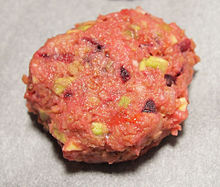
This is a list of meat substitutes. A meat substitute, also called a meat analogue, approximates certain aesthetic qualities (primarily texture, flavor and appearance) or chemical characteristics of a specific meat. Substitutes are often based on soybeans (such as tofu and tempeh), gluten, or peas.[1] Whole legumes are often used as a protein source in vegetarian dishes, but are not listed here.
General[edit]
- Vegetarian bacon – sometimes made from tempeh.
- Vegetarian hot dog
- Vegetarian sausage
- Vegetarian burger
- Vegan chicken nuggets – made from pea protein, soy protein, textured vegetable protein, and wheat gluten
- Tofurkey – faux turkey, a meat substitute in the form of a loaf or casserole of vegetarian protein, usually made from tofu (soybean protein) or seitan (wheat protein) with a stuffing made from grains or bread, flavored with a broth and seasoned with herbs and spices
- Cauliflower – coated in flour and baked or fried to imitate chicken wings or steak
- Leaf protein concentrate
- Meat extenders – sometimes but not always soy-based
- Mock duck
- Nut roast
- Seitan – a food made from wheat gluten, with wheat being a grain.
-
Sliced nut roast with brussels sprouts
-
Veggie burgers prepared from beans being cooked
-
Vegetarian hot dog sausages from Germany
Dairy-based[edit]

- Glamorgan sausage[2] – a traditional Welsh vegetarian sausage named after the historic county of Glamorgan in Wales.
- Paneer[3] – for example in such dishes as Paneer tikka
Fungi-derived[edit]
- Edible mushrooms[4]
- Mycoprotein – a form of single-cell protein, also known as fungal protein, it is able to provide greater satiety than traditional protein sources such as chicken, while also being rich in protein and low in caloric content
- Fistulina hepatica – a common mushroom known as beefsteak fungus
- Laetiporus – a mushroom which is also named chicken of the woods
- Lyophyllum decastes – a mushroom known as fried chicken mushroom
- Pleurotus ostreatus – better known as the oyster mushroom, famous in the vegan community as one of the best substitutes for fried chicken
Fruit-based[edit]
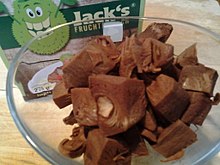
- Breadfruit – used similarly as jackfruit in savory dishes
- Coconut burger – made from sapal, the coconut pulp by-products of traditional coconut milk extraction in Filipino cuisine
- Eggplant – semitropical/tropical plant with a highly textured flesh[5]
- Grapefruit – during the course of the Special Period economic crisis Cubans prepared steaks made out of breaded and fried grapefruit rind known as "bistec de toronja".[6]
- Jackfruit – a fruit whose flesh has a similar texture to pulled pork when cooked
Legume-based[edit]
- Burmese tofu – made from water, chickpea flour and turmeric
- Falafel – a traditional Middle Eastern bean fritter, believed to have been created by ancient Copts as a meat substitute during Lent
- Härkis – a brand of processed ground fava beans
Soy-based[edit]
- Tofu, made from soy/soybeans.
- Textured vegetable protein – a defatted soy flour product that is a by-product of extracting soybean oil.[7] It is often used as a meat analogue or meat extender. It is quick to cook, with a protein content that is comparable to certain meats.[8]
- Ganmodoki – a traditional Japanese tofu based dish similar to veggie burgers

- Tempeh – a traditional Indonesian soy product in a cake form, made from fermented soybeans
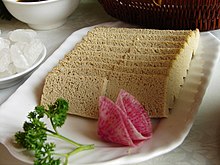
- Injo-gogi-bap – a Korean steamed rice wrapped in leftover soybean paste and dressed with a chili sauce.
- Oncom – one of the traditional staple foods of West Java (Sundanese) cuisine of Indonesia, there are two types: red oncom and black oncom. Oncom is closely related to tempeh; both are foods fermented using mold.[9]
- Koya dofu – a freeze-dried tofu that has a taste and texture similar to meat when prepared, common in Buddhist vegetarian cuisine
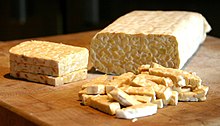
Companies and brands[edit]
See also[edit]
References[edit]
- ^ Strom, Stephanie (3 April 2014). "Fake Meats, Finally, Taste Like Chicken". The New York Times. Retrieved 17 November 2018.
- ^ Godwin, Nigel (27 February 2009). "St David's Day recipes: Glamorgan sausages". The Daily Telegraph. Retrieved 4 March 2012.
- ^ "Meat Fans, You Have To Try These 3 Paneer-Based Versions Of Your Favourite Dishes". NDTV Food. 14 April 2020. Retrieved 19 May 2020.
- ^ Nowak, Rhonda (2 February 2020). "How to grow edible mushrooms". Mail Tribune. Retrieved 19 May 2020.
- ^ "On-farm trials of eggplant". AGRIS: International Information System for the Agricultural Science and Technology. Retrieved 19 May 2020.
- ^ "Cuba: A Little Hunger and Lot of Poor Eating". Havana Times. 2 May 2012. Retrieved 5 February 2021.
- ^ Riaz MN (2006). Soy applications in food. Boca Raton: CRC Press. pp. 155–84. ISBN 0-8493-2981-7.
- ^ Clark JD, Valentas KJ, Levine L (1991). Food processing operations and scale-up. New York: CRC Press. pp. 134–7. ISBN 0-8247-8279-8.
- ^ Sastraatmadja, D. D.; et al. (2002). "Production of High-Quality Oncom, a Traditional Indonesian Fermented Food, by the Inoculation with Selected Mold Strains in the Form of Pure Culture and Solid Inoculum". J. Grad. SCH. Agr. Hokkaido Univ. 70: 111–127. hdl:2115/13163.
- ^ Luna, Nancy (November 12, 2007). "Kellogg buys Irvine-maker of Gardenburger frozen foods". The Orange County Register. Archived from the original on June 5, 2013. Retrieved July 27, 2012.
External links[edit]
 Media related to Meat substitutes at Wikimedia Commons
Media related to Meat substitutes at Wikimedia Commons

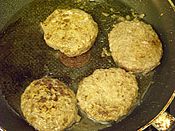

Well, that’s interesting to know that Psilotum nudum are known as whisk ferns. Psilotum nudum is the commoner species of the two. While the P. flaccidum is a rare species and is found in the tropical islands. Both the species are usually epiphytic in habit and grow upon tree ferns. These species may also be terrestrial and grow in humus or in the crevices of the rocks.
View the detailed Guide of Psilotum nudum: Detailed Study Of Psilotum Nudum (Whisk Fern), Classification, Anatomy, Reproduction